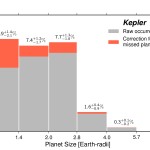W. M. Keck Observatory press release…
A team of astronomers from the University of California, Berkeley and the University of Hawaii at Manoa has found that 17 percent of all sun-like stars have planets one to two times the diameter of Earth in close orbits. The finding, based on an analysis of the first three years of data from NASA’s Kepler mission and the W. W. Keck Observatory on the summit of Mauna Kea, Hawaii, was announced at the American Astronomical Society meeting in Long Beach, California this week.
While other studies had shown that planets around stars are common in our galaxy, until this study, it remained unclear if this is true for Earth-size planets.

To find planets, the Kepler space telescope repeatedly images 150,000 stars in a small region of the sky. It looks for a tiny dip in each star’s brightness that indicates a planet is passing in front of it, much like Venus passed between Earth and the sun last summer.
We took a census of the planets detected by the Kepler Space Telescope,” said Howard. “Erik Petigura wrote a new pipeline to detect the shallow dimmings of Earth-size planets in Kepler photometry. With his efficient and well-calibrated pipeline we could confidently report the size distribution of close-in planets down to Earth-size. The result is that Earth-size planets are just a common as planets twice Earth size. Remarkable.”
The Keck Observatory played a crucial role in this project, he said. While these planets were detected by the space-borne Kepler Telescope, the mighty Keck I Telescope fitted with HIRES (High Resolution Echelle Spectrograph) and a newly upgraded guider system were used to characterize the host stars of the newly discovered planets and to rule out any false planet detections from Kepler. “We took HIRES spectra of most of the planet host stars to characterize the Kepler-discovered systems and to search for double lines (which would indicate a possible false planet detection),” he said.The Observatory’s HIRES was improved in 2012 with Keck’s custom Multi-object Acquisition, Guiding and Image Quality, or MAGIQ, system to dramatically improve the instrument’s performance. MAGIQ was made possible by contributions from the Observatory’s growing base of private supporters.
Broadly speaking, new the MAGIQ guide camera is helpful for several reasons: “The wider field of view, finer pixel scale, and improved noise characteristics make the experience of observing more efficient – and enjoyable,” Howard said. “Those characteristics also yield better guiding on faint stars, which improves our efficiency and crucially improves the stability of the HIRES spectra.”
The team’s estimate includes only planets that circle their stars within a distance of about one-quarter Earth’s orbital radius – well within the orbit of Mercury – which is the current limit of Kepler’s detection capability. Further evidence suggests that the fraction of stars having planets the size of Earth or slightly bigger orbiting within Earth-like orbits may be as high as 50 percent.
Planets one to two times the size of Earth are not necessarily conducive to life. Painstaking observations by the team show that planets two or three times the diameter of Earth are typically like Uranus and Neptune, which have a rocky core surrounded by helium and hydrogen gases and perhaps water. Planets close to their stars may even be water worlds – planets with oceans hundreds of miles deep above a rocky core.
Nevertheless, planets between one and two times the diameter of Earth may well be rocky and, if located within the Goldilocks zone – not too hot, not too cold, just right for liquid water – could harbor life.
“Kepler’s one goal is to answer a question that people have been asking since the days of Aristotle: What fraction of stars like the sun have an Earth-like planet?” Howard said. “We’re not there yet, but Kepler has found enough planets that we can make statistical estimates.”
For planets as large as Jupiter, the star may dim by 1 percent, or one part in a hundred, which is easily detectable. A planet as small as Earth, however, dims the star by one part in 10,000, which is easy to lose in the noise, Petigura said. The software used by the Kepler mission is not optimized for finding these planets, so Petigura spent the past two years writing a software program called TERRA, for Transiting Exoearth Robust Reduction Algorithm. The UC Berkeley/Hawaii team then fed TERRA simulated planets to test how efficiently the software detects Earth-size planets.
“It may seem crazy to spend two years redoing what the Kepler team has already done, but the question we are asking – How many Earth-size planets are we missing? – is so important that we wanted to do it separately for cross-validation,” he said.
An analysis of three years of Kepler observations identified 119 Earth-like planets ranging in size from nearly six times the diameter of Earth to the diameter of Mars. Thirty-seven of these planets were not identified in previous Kepler reports.
“A year ago, Kepler had found only a few planets smaller than twice Earth’s diameter, far fewer than would be expected if you extrapolate downward from the abundances of larger planets,” Petigura said. Accounting for planets that Kepler misses still means that big Earths are one-third as abundant as would be expected if the rising trend continued below twice the diameter of Earth.
Howard noted, however, that if 17 percent of all stars have big Earths within the orbit of Mercury, “where are they in our solar system? Maybe our solar system is an anomaly compared to the great variety of stars.”
Petigura’s work was supported by a National Science Foundation graduate student fellowship.


Way cool!! We tune in here to keep up to date on da astro happenings. We thank you.
Aloha